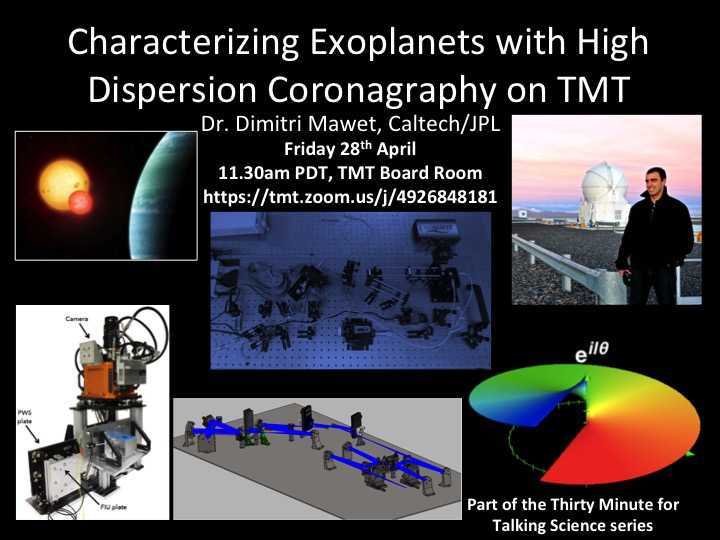

Announcing the next talk of the TMTS series (Thirty Minutes for Talking Science):
Dr. Dimitri Mawet, Caltech/JPL
Characterizing Exoplanets with High Dispersion Coronagraphy on TMT
Friday 28th September, 11.30am PDT, TMT Project Office Board Room
Requests for remote participation by Zoom to Warren Skidmore (was@tmt.org)
High-dispersion coronagraphy (HDC) optimally combines high-contrast imaging techniques such as adaptive optics/wavefront control plus coronagraphy to high spectral resolution spectroscopy. HDC enables the full characterization of exoplanet atmospheres across a broad range of masses from giant gaseous planets down to Earth-like planets. In addition to determining molecular compositions, HDC also enables Doppler mapping of atmosphere inhomogeneities (temperature, clouds, wind), as well as precise measurements of exoplanet rotational velocities (length of day). Here, we present results from end-to-end numerical simulations and the laboratory demonstration of an innovative concept for injecting the directly imaged planet light into a single-mode fiber, linking a high-contrast adaptively corrected coronagraph to a high-resolution spectrograph. Our proof of concept in the Caltech Exoplanet Technology Laboratory includes three key milestones: close-to-theoretical injection efficiency, accurate pointing and tracking, and on-fiber coherent modulation and speckle nulling of spurious starlight signal coupling into the fiber. Using the extreme modal selectivity of single-mode fibers, we also demonstrated speckle suppression gains that outperform conventional image-based speckle nulling. A Fiber Injection Unit demonstrator based on the HDC concept has recently been deployed at W.M. Keck Observatory, as part of the Keck Planet Imager and Characterizer (KPIC). The KPIC FIU will proof-test HDC on segmented telescopes, a stepping stone towards the future TMT Planetary System Imager (PSI), and the proposed MODHIS concept.